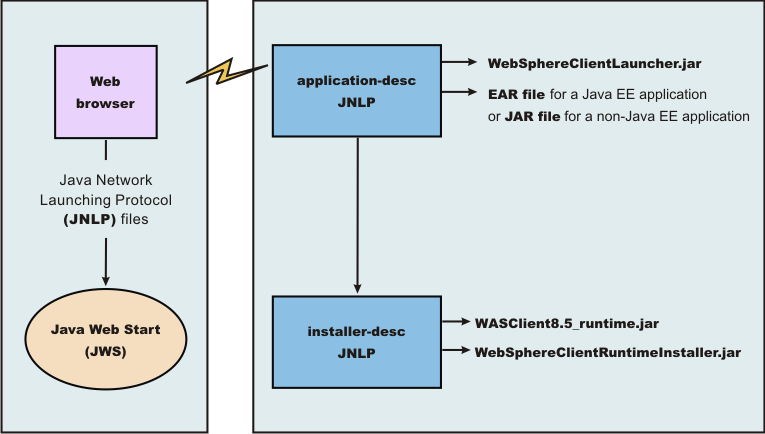Java Web Start architecture for deploying application clients
Java Web Start is an application-deployment technology that includes the portability of applets, the maintainability of servlets and JSP file technology, and the simplicity of mark-up languages such as XML and HTML. It is a Java application that allows full-featured Java EE client applications to be launched, deployed and updated from a standard Web server. The Java Web Start client is used with platforms that support a web browser.
(iseries) Java Web Start is not supported.
Upon launching Java Web Start for the first time, we might download new client applications from the Web. Each time you launch JWS thereafter, we can initiate applications either through a link on a web page or (in Windows) from desktop icons or the Start menu. We can deploy applications quickly using Java Web Start, cache applications on the client machine, and launch applications remotely offline. Additionally, because Java Web Start is built from the Java EE infrastructure, the technology inherits the complete security architecture of the Java EE platform.
The technology underlying Java Web Start is the Java Network Launching Protocol & API (JNLP). Java Web Start is a JNLP client and it reads and parses a JNLP descriptor file (JNLP file). Based on the JNLP descriptor, it downloads appropriate pieces of a client application and any of its dependencies. If any of the pieces of the application are already cached on the client machine, then those components are not downloaded again, unless they have been updated on the server machine. After we download and cache the client application, JWS launches it natively on the client machine.
The following diagram shows an overview of launching a client application, include the Application Client for WebSphere Application Server as a dependent resource, using Java Web Start.

The web browser running on a client machine connects to a web application located on a server machine. The client application JNLP descriptor file is downloaded and processed by Java Web Start on the client machine.
In this diagram, there are two JNLP descriptor files:
- Client application JNLP descriptor (application-desc in the diagram)
- Application Clients run-time installer JNLP descriptor (installer-desc in the diagram)
Each of these JNLP descriptor files, the client application (JAR or EAR) and the dependent resource JAR files are packaged as web applications in an EAR file. This EAR file is deployed to an Application server. The client machine with JWS installed uses a web browser to connect to the URL of the client application JNLP descriptor file to download and run the client application.
Use Java Web Start from Java SE Runtime Environment 6.0 or later is highly recommended. All the platforms supported by the application client for WebSphere Application Server are supported with the exception Linux on Power and OS/400 platforms.
We can use the following:
- Java Web Start on the Java Standard Edition Developer Kits that IBM provides, packaged in Application Client for WebSphere Application Server
- Java Web Start on Java SE
6 Development Kit or Java SE
Runtime Environment 6.0, which we can download from the Oracle website for Windows, Linux and Solaris operating systems
- Java Web Start on HP-UX JDK or JRE for Java Platform, Standard Edition, Version 6, which we can download from the HP website
Subtopics
- buildClientLibJars tool
For a Java EE application client application and or Thin application client application to be launched using Java Web Start (JWS), the properties files bundled in Application Client for WebSphere Application Server must be installed in the Java Web Start. Use this tool to create those property JAR files. The Java Web Start client is used with platforms that support a web browser.
Related tasks
Related information: